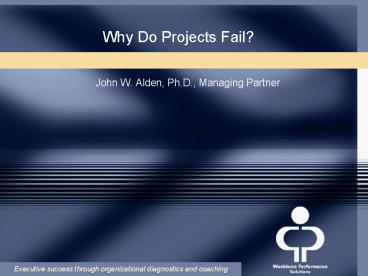Why Do Projects Fail - PowerPoint PPT Presentation
1 / 21
Title:
Why Do Projects Fail
Description:
Coors Success Model linkage. Update Job in HR Database. Evaluate impact to Organization Structure ... Source: Coors. L. 19 2005 John W. Alden, Workforce ... – PowerPoint PPT presentation
Number of Views:53
Avg rating:3.0/5.0
Title: Why Do Projects Fail
1
Why Do Projects Fail?
- John W. Alden, Ph.D., Managing Partner
2
Agenda
- Why do projects fail?
- Workforce performance
- Aspects of success
- Alignment (A)
- Knowledge, Skills and Abilities (IKSA)
- Organizational Process Maturity (OPM)
- Defining workforce performance initiatives
- Q and A
3
Why Do Projects Fail?
- Understanding the requirements
- Changing needs
- Understanding of context-process
- Challenged management
- Communication gaps
- Insufficient
- Misunderstood
- Undocumented
- Haste
- Decision making with knowledge basis
- Business model not well defined
- Others
All impact workforce performancewhats the root
cause?
4
2B Public Product/Services Company Absence of
End to End Capability
Vague Requirements
Increased Rework
Fixed Date, Budget
Increased Service Calls
Deferred Items
In
Out
Liquidated Damages
Defects
Ineffective Execution of Product Strategy
Customer Dissatisfaction
Immature Products
The hidden costs grow from project to project
5
Practical Definitions
- Alignment
- We arent on the same page
- Individual Knowledge, Skills and Abilities (IKSA)
- Our people do not have industry leading skills
- Organizational Process Maturity (OPM)
- Our error rate in the ____department is huge
6
Alignment The Concept and Some Details
- Alignment is the agreement and effective
communication about - What (s)
- When (s)
- Who (s)
- How (s)
- Everything else
- Discipline achieved through
- Practice
- Personal relationships
- Experience
- Thinking insightfully about complexity
- Simplicity (verbs, we, )
- Active listening
- Common vocabulary
- Commitment to coordinated actions
How does successful communication happen across
organizational silos?
7
Two Cultures Worlds Apart
Business
IT
- Helpful Metaphors
- Diet and exercise
- Building a new house
- Travel to a foreign country
- People do not like change
8
Alignment Are Business and IT on the Same Page?
High
Understand strategy
What is Ideal?
B
IT
Low
High
Understand implications for my work
9
Metrics Aligned To Enterprise Process Framework
Source APQC
10
Organization Maturity Levels
Level 5 Optimizing
Continuously improve
Process Improvement program
Control variation
Level 4 Managed
Develop common processes
Quantitative management
Level 3 Defined
Manage using tailored processes
Level 2 Repeatable
Stabilize project
Project management
Level 1 Initial
11
How Would We Rate Business And IT ?
High
IT
Technology Understanding
What is Ideal?
B
High
Low
Business Process Maturity
12
Knowledge, Skills Abilities Wide Variance by
Level
Source Don Oxley, Borland
13
What does this look like when its altogether?
- Alignment
- We arent on the same page
- Individual Knowledge, Skills and Abilities (IKSA)
- Our people do not have industry leading skills
- Organizational Process Maturity (OPM)
- Our error rate in the ____department is huge
14
Enterprise Process Blueprint
15
Enterprise Process MapEnabling Process
Communication, Collaboration, Control
Enterprise Process Map
- Process Owners
- Collaborate on process scope and interfaces
- Communicate standard processes and process
changes - Process Users
- Easy intuitive access to processes, checklists,
templates, tools - Ask questions and provide feedback on process
problems
Sub-processes, activities and interfaces have
links to metrics, documents, tools, templates,
checklists
16
Enterprise Process Map
17
(No Transcript)
18
Process Links to Workforce Performance
Process Design/ Modeling
Linkages
L
- Job Design
- Changes in current job(s)
- Creation of new job(s)
- Technical Competencies
- Coors Success Model linkage
- Update Job in HR Database
- Evaluate impact to Organization Structure
- System Access Requirements
- Training Development
- Requirements defined
- Curriculum planning
- Tools / materials available
- Role or system specific
Reports Activity by Role
Role
Activity
Process
System
Transaction
Relationtype
Beer Flow
Place Product on
HOW Hold Finished
WITS
MB1B
executes
Coordinator
Hold
Product
- Headcount Analysis
- Cycle time per activity
- Volume by location
- Estimate total work
- Determine headcount/organization coverage
- Evaluate impact to organization structure
Beer Flow
Place Product on
HOW Hold Finished
SAP R/3 WM
MB1B
executes
Coordinator
Hold
Product
Beer Flow
Create FPH
HOW Hold Finished
SAP R/3
ZMFPH1
executes
Coordinator
Record
Product
Beer Flow
Change Inventory
HOW Hold Finished
SAP R/3 WM
MB1B
executes
Coordinator
Status
Product
Beer Flow
Change Inventory
HOW Hold Finished
WITS
MB1B
executes
Coordinator
Status
Product
Source Coors
19
Specific Areas of Improvement
Customer Needs Marketing
Innovation
Delivery
IT
Sales Products
IT Process Maturity Improvement-OPM
Business Process Maturity Improvement-OPM
- Enterprise wide organization improvements
- Leadership development and team building A,
IKSA, OPM - Drive transformation end to end by achieving
process maturity in all relevant organizations
OPM - Design enact and live customer centric behavior
OPM - Managing Talent IKSA, OPM
- recruit experienced top performers and
continuously update skills and knowledge - manage human performance by results measures
- Enable processes with appropriate technology OPM
20
Organizations That Invest In HC Are Winners!
Source Accenture
21
Discussion Implications For Our Research
- Thank you!
- Questions, Comments































